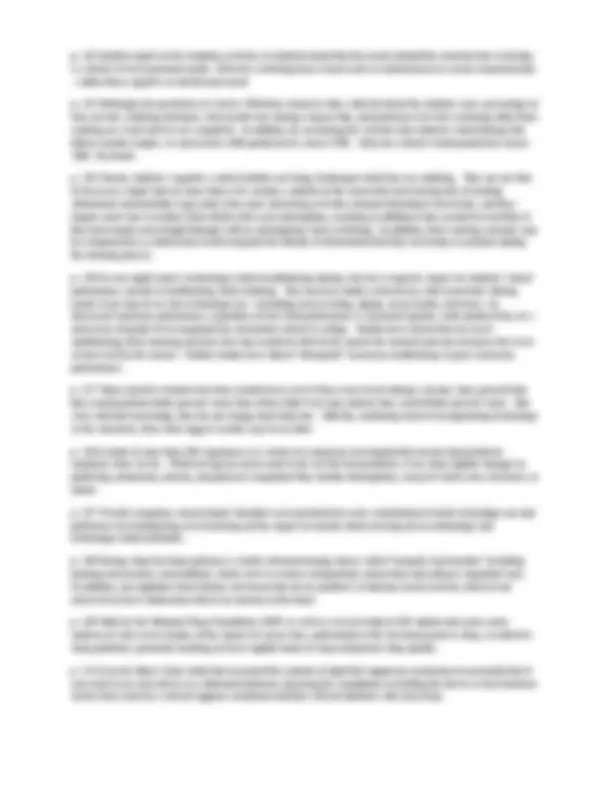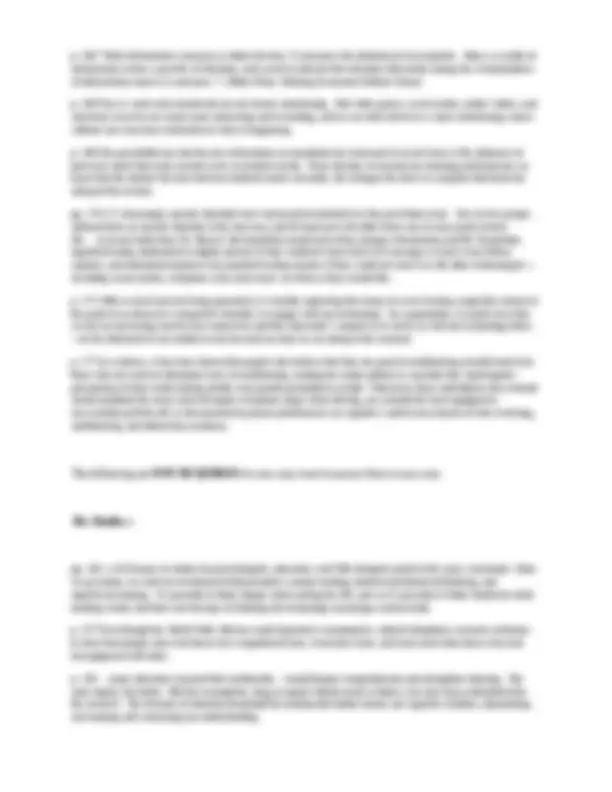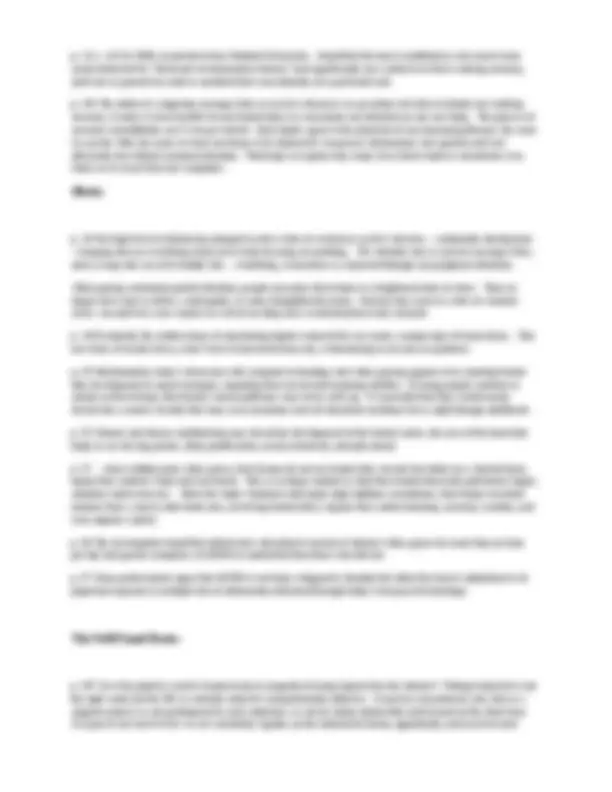





Study with the several resources on Docsity

Earn points by helping other students or get them with a premium plan


Prepare for your exams
Study with the several resources on Docsity

Earn points to download
Earn points by helping other students or get them with a premium plan
Community
Ask the community for help and clear up your study doubts
Discover the best universities in your country according to Docsity users
Free resources
Download our free guides on studying techniques, anxiety management strategies, and thesis advice from Docsity tutors
An overview of the findings from various studies on the effects of technology use on attention, working memory, and goal management. The studies discussed in the document suggest that excessive technology use can reduce intelligence, impair memory encoding, and negatively impact academic performance. The document also highlights the importance of focusing on one task at a time and limiting technology use to improve cognitive abilities.
Typology: Exercises
1 / 7

This page cannot be seen from the preview
Don't miss anything!




Norton & Co., 2010, iBrain: Surviving the Technological Alteration of the Modern Mind , by UCLA neuroscientist Gary Small & Gigi Vorgan, HarperCollins, 2008, Brainwork by David A. Sousa, Triple Nickel Press, 2012, The Well-Tuned Brain: Neuroscience and the Life Well Lived by neuroscientist Peter C. Whybrow, W.W. Norton, 2015, The Distracted Mind: Ancient Brains in a High-Tech World by Adam Gazzaley and Larry D. Rosen, The MIT Press,
https://www.wired.com/2017/03/irresistible-the-rise-of-addictive-technology-and-the- business-of-keeping-us-hooked/
In late 2010, Steve Jobs told New York Times journalist Nick Bilton that his children had never used the iPad. “We limit how much technology our kids use in the home.”
Bilton discovered that other tech giants imposed similar restrictions. Chris Anderson, the former editor of WIRED , enforced strict time limits on every device in his home, “because we have seen the dangers of technology firsthand.” His five children were never allowed to use screens in their bedrooms. Evan Williams, a founder of Blogger, Twitter, and Medium, bought hundreds of books for his two young sons, but refused to give them an iPad. And Lesley Gold, the founder of an analytics company, imposed a strict no-screen-time-during-the-week rule on her kids. She softened her stance only when they needed computers for schoolwork…
This is unsettling. Why are the world’s greatest public technocrats also its greatest private technophobes? It seemed as if they were following the cardinal rule of drug dealing: never get high on your own supply.
In truth, addiction is produced largely by environment and circumstance. Steve Jobs knew this. He kept the iPad from his kids because, for all the advantages that made them unlikely substance addicts, he knew they were susceptible to the iPad’s charms. These entrepreneurs recognize that the tools they promote—engineered to be irresistible—will ensnare users indiscriminately. There isn’t a bright line between addicts and the rest of us. We’re all one product or experience away from developing our own addictions.
p. 24 As long as we call on tasks that call on two brain regions with separate responsibilities, we are able to carry them out successfully. But when we call on the same part of the brain to carry out two or more functions simultaneously, problems arise.
p. 26 Research studies…have shown that the cognitive impairments that occur when using a cell phone while driving are as serious as those associated with driving while drunk. That’s scary. If you are thinking that hands-free or voice-activated cell phones are safer, you are mistaken. These studies showed that they made little difference in the driver’s level of distraction.
Does talking to someone in the car involve the same amount of distraction? No…although talking with a passenger involves some diversion of attention, it is far less than the distraction of a phone conversation…Furthermore, the passenger is an extra set of eyes to alert you to road hazards.
p. 29 They found that excessive use of technology actually reduced workers’ intelligence…Participants who had a lack of discipline in handling emails had the largest IQ loss…There is growing research evidence that consistent attempts at multitasking affect our brain’s ability to encode information into long-term memory.
p. 31 The researchers speculated that high multitaskers might have substantially developed one or more of the following abilities to:
Filter out irrelevant information
Switch rapidly from one task to another
Keep information neatly organized in working memory
After repeated experiments with more than 260 participants, it turned out the supposed high-multitaskers were terrible at all three. Follow-up experiments showed that the multitaksers were also worse at analytical reasoning.
p. 33 Researchers have known for a long time that females are better at physical multitasking than men….researchers find no difference between males and females when it comes to cognitive multitasking. Both genders are equally bad at it.
p. 34 The message here is simple: focus on one thing, and switch irrelevant technology off.
p. 63 It is now well understood by neuroscientists that our cognitive control abilities are far from ideal. Each of the components—attention, working memory, and goal management—have deeply embedded functional limitations that result in suboptimal performance as we attempt to accomplish our goals. This is especially true when our goals lead us to engage in interference-inducing behaviors—multitasking in distracting settings—which is now commonplace in our high-tech world.
p. 105 As we see it, three major technology breakthroughs have been monumental game changers in our current lifetime: the Internet, social media, and smartphones. By game changers we mean technologies that drive our interference-inducing behaviors—both internally and externally—and which ultimately aggravate our Distracted Minds.
p. 111 Shockingly, students could not focus for more than three to five minutes even when they were told to study something very important. This study replicated work by Dr. Gloria Mark and her colleagues at the University California, Irvine, who observed that IT workers were easily and frequently interrupted.
p. 112 The vast majority of young people check their smartphones every fifteen minutes or less and three out of four young adults sleep with their smartphones nearby with the ringer on or on vibrate so as not to miss a nighttime alert….Where we used to read, we now skim. Where we used to write, we now use shortened fragments to convey our thoughts….Eye-tracking studies show that when we read a webpage or any text on a screen we don’t read it in the same way that we read a book. Rather than our eyes passing from word to word along each successive line of text,, we tend to read in an “F” pattern, where we read the top and left sides of the page, with a brief foray into the text somewhere in the middle, rather than the complete page line by line. Add in hyperlinks, ads, multimedia videos, and all of the other enticing distractions on a webpage, and it is not surprising that we have difficulty attending anything for more than a few minutes.
p. 150 “What information consumes is rather obvious: It consumes the attention of its recipients. Hence a wealth of information creates a poverty of attention, and a need to allocate that attention efficiently among the overabundance of information sources it consumes.”—Nobel Prize-Winning Economist Herbert Simon
p. 166 Face it: work and schoolwork are not always entertaining. But video games, social media, online videos, and electronic missives are much more interesting and rewarding, and we are often driven to a more entertaining source without our conscious realization of what is happening.
p. 168 One possibility for why the rate of boredom accumulation has increased in recent times is the influence of pervasive short timescale reward cycles in modern media. From decades of research on learning and behavior, we know that the shorter the time between reinforcements (rewards), the stronger the drive to complete that behavior and gain the reward.
pp. 170-171 Amazingly, anxiety disorders have increased twentyfold over the past thirty years. One in five people suffered from an anxiety disorder in the last year, and 28.8 percent will suffer from one at some point in their life….A recent study from Dr. Rosen’s lab found that nearly half of the younger iGeneration and Net Generation reported feeling moderately to highly anxious if they could not check their text messages at least every fifteen minutes, and substantial numbers also reported feeling anxious if they could not check in with other technologies— including social media, cell phone calls, and email—as often as they would like.
p. 174 With so much anxiety being generated, it is hardly surprising that many of us are feeling compelled, almost to the point of an obsessive-compulsive disorder, to engage with our technology. As a population, it would seem that we feel an increasing need to stay connected, and this obsession” compels us to check in with our technology often —to the detriment of our ability to stay focused on what we are doing in the moment.
p. 177 As evidence, it has been shown that people who believe that they are good at multitasking actually tend to be those who do worst on laboratory tests of multitasking, leading the study authors to conclude that “participants’ perceptions of their multi-tasking ability were poorly-grounded in reality.” Moreover, those individuals who actually media multitask the most, and self-report cell phone usage while driving, are actually the least equipped to successfully pull this off, as documented by poorer performance on cognitive control assessments of task switching, multitasking, and distraction resistance.
pp. 115—116 Dozens of studies by psychologists, educators, and Web designers point to the same conclusion: when we go online, we enter an environment that promotes cursory reading, hurried and distracted thinking, and superficial learning. It’s possible to think deeply while surfing the Net, just as it’s possible to think shallowly while reading a book, but that’s not the type of thinking the technology encourages and rewards.
p. 127 Even though the World Wide Web has made hypertext commonplace, indeed ubiquitous, research continues to show that people who read linear text comprehend more, remember more, and learn more than those who read text peppered with links.
p. 129 …many educators assumed that multimedia…would deepen comprehension and strengthen learning. The more inputs, the better. But this assumption, long accepted without much evidence, has also been contradicted by the research. The division of attention demanded by multimedia further strains our cognitive abilities, diminishing our learning and weakening our understanding.
p. 141—142 In 2009, researchers from Stanford University…found that the heavy multitaskers were much more easily distracted by “irrelevant environmental stimuli,” had significantly less control over their working memory, and were in general less able to maintain their concentration on a particular task.
p. 194 The influx of competing messages that we receive whenever we go online not only overloads our working memory; it makes it much harder for our frontal lobes to concentrate our attention on any one thing. The process of memory consolidation can’t even get started. And, thanks again to the plasticity of our neuronal pathways, the more we use the Web, the more we train our brains to be distracted—to process information very quickly and very efficiently but without sustained attention. That helps to explain why many of us find it hard to concentrate even when we’re away from our computers.
p. 18 Our high-tech revolution has plunged us into a state of continuous partial attention… continually staying busy —keeping tabs on everything while never truly focusing on anything…We virtually chat as our text messages flow, and we keep tabs on active buddy lists…everything, everywhere is connected through our peripheral attention.
When paying continuous partial attention, people may place their brain in a heightened state of stress. They no longer have time to reflect, contemplate, or make thoughtful decisions. Instead, they exist in a state of constant crisis—on alert for a new contact or a bit of exciting news or information at any moment.
p. 19 Eventually, the endless hours of unrelenting digital connectivity can create a unique type of brain strain…This new form of mental stress, what I term techno brain burn-out, is threatening to become an epidemic.
p. 32 Unfortunately, today’s obsession with computer technology and video gaming appears to be stunting frontal lobe development in many teenagers, impairing their social and reasoning abilities. If young people continue to mature in this fashion, their brains’ neural pathways may never catch up. It is possible that they could remain locked into a neural circuitry that stays at an immature and self-absorbed emotional level, right through adulthood.
p. 32 Chronic and intense multitasking may also delay development of the frontal cortex, the area of the brain that helps us see the big picture, delay gratification, reason abstractly, and plan ahead.
p. 37 …when children play video games, their brains do not use frontal lobe circuits but rather use a limited brain region that controls vision and movement. This is in sharp contrast to what they found when kids performed simple, mundane math exercises. When the study volunteers did single-digit addition calculations, their brains recruited neurons from a much wider brain area, involving frontal lobes, regions that control learning, memory, emotion, and even impulse control.
p. 66 The investigators found that adolescents who played console or Internet video games for more than an hour per day had greater symptoms of ADHD or inattention than those who did not.
p. 67 Some professionals argue that ADHD is not truly a diagnostic disorder but rather the brain’s adaptation to its perpetual exposure to multiple bits of information delivered through today’s fast-paced technology.
p. 287 So is the playful, creative human brain in jeopardy of being hijacked by the Internet? Perhaps hijacked is not the right word, but the Net is certainly seductive and potentially addictive. It must be remembered, also, that as a migrant animal, we are predisposed to such seduction: we are by nature distractible and focused on the short term. It is part of our survival kit: we are constantly vigilant, on the lookout for threat, opportunity, and social reward.